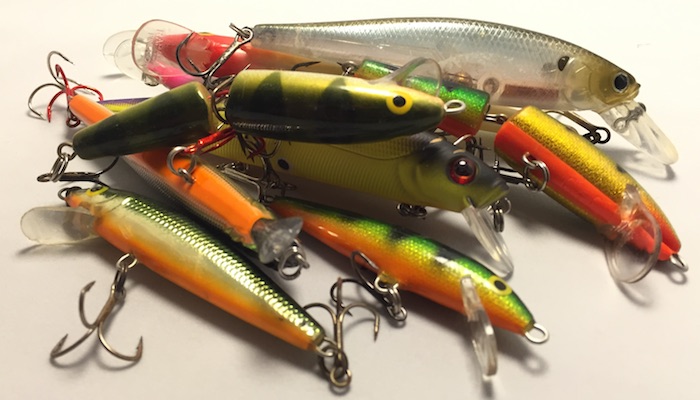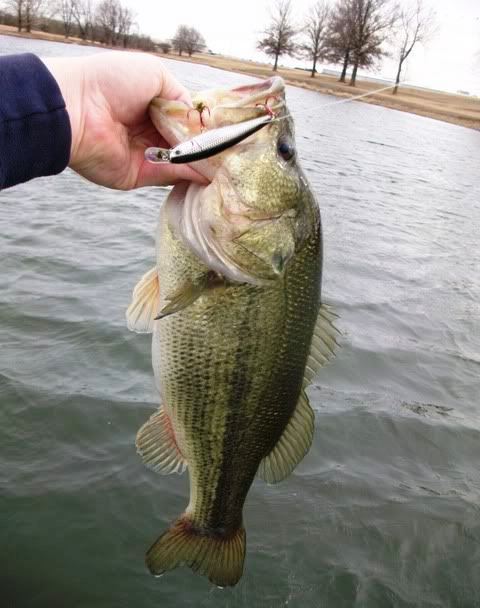Jerkbaits are one of the few bass lures that are highly effective year round. The main reason is because of how much control you have over their action. They can be fished extremely fast or slow, deep or shallow, or anywhere in between.
A jerkbait is a longish lure made to represent an injured baitfish, and has no real action of its own. In jerkbait fishing the action is created by the angler. This is done by jerking your rod as you reel the lure in. Every time you jerk the rod, the bait will shoot off in different directions. This imitates the last swimming strides of a dying baitfish, which is a dinner bell for bass.
Many models have a lip like a crankbait to make them dive, but that’s about all you will get without adding your own action to it. The bait will wobble if reeled in a straight retrieve but it’s the jerking of the rod tip that makes these lures unique. Jerkbait fishing is a method of fishing in itself, you’ll sometimes hear anglers referring to other lures saying “fish it like a jerkbait”.
Although they are very effective year round, jerkbaits are best known for their ability to get bites in cold water, that’s what makes them so popular in early spring and fall. Bass slow down big time in cold water and since you can work a jerkbait as slow as you want, they make a desirable meal for a sluggish bass.
Contents
Types of Jerkbaits
There are many different kinds of jerkbaits out there, but they can basically be broken down into two major categories: hard bodied and soft bodied. Each style has its own strengths and weaknesses in bass fishing.
What determines which to choose is the areas of the lake your targeting and what kind of action you want the lure to give off. Let’s start by discussing some of the hard body styles.
Hard Jerkbaits
These baits are made from hard plastic, polymers, or wood. They are very durable and because of their aerodynamic shape you can cast them a mile. Most hard jerkbaits come equipped with two or three treble hooks are comprised of a single solid body, but there are also jointed versions.
Jointed jerkbaits are made up of two body sections, a front and a rear, that are connected by a eyelet. The connection gives the two sections a hinging action and will put out more movement than the solid body models. Jointed or not, hard body jerkbaits can be broken down into three subcategories: Floating, Suspending, and Sinking
Floating
Floating jerkbaits remain on the surface until some action is put in to them. They are the best jerkbait for beginners because their floating attribute helps them from getting hung up on weeds and timber below the surface.
Most models have a lip on the front that make them plunge as they are retrieved. With every jerk of your rod tip, the bait will dive a little deeper. During the pause between jerks the bait will float back up, so it’s the time between jerks that determines what depth the lure will be working in.
They are also great when fished as a topwater, by letting them float and giving them a jerk to make them dive a few inches and pop back up to the surface.
Sinking
These are designed to sink at different sink rates until action is imparted to them by jerking the rod. They are most often used for targeting deep cover or structure by letting the bait sink down to the target zone and then begin applying action.
Usually anglers will use the countdown method, so you should know what the sink rate of your bait is. Most sinking jerkbaits will have the sink rate on the package but if not you can find out yourself by letting it sink in water that you know the depth of and counting the seconds it takes to hit the bottom. Sink rate is measured in feet per second.
Suspending
These are the most commonly used style of jerkbait. They are designed to have a neutral buoyancy, and hang in the water column at mid-depths, neither sinking or floating. This suspending pause gives the bait a natural appearance and time for a bass to devour it.
When you cast one out and it hits the water, it will plunge just beneath the waters surface. You need to jerk the rod and get it down to the depth you want to fish it. You do this by keeping the rod tip low as you jerk the bait.
Once you’ve hit the depth you desire bring the rod tip up so that its straight out in front of you and parallel with the surface of the water. If you want to bring the bait up in the water column raise the rod tip up as you jerk it.
Soft Jerkbaits
These are made from soft plastic and have a chewy texture, giving them a lifelike feel to a bass that bites one. That attribute gives these style jerkbaits a big advantage because bass hang on to them a little longer before trying to spit them out, giving you more time for a proper hook set.
Their soft bodies also give them a more natural appearance and movement underwater. When you jerk a soft jerkbait they dart off in all different directions. This action is extremely appealing to bass because it’s not a repetitive action like most lures give off.
Typically they are Texas rigged so they are weedless so they can be fished just about anywhere. They can also be weighted if your looking to target deeper water.
One down side when compared to hard jerkbaits is that they are more easily damaged. Like all soft plastic baits, they only last so long and can only catch so many fish before they get torn to pieces. They’re also pickerel magnets, so they won’t stand up to too many encounters with those teeth.
The other disadvantage that an angler needs to keep a close eye on is the line twists soft jerkbaits can cause. Darting off in different directions can twist the line, especially if not rigged correctly. It’s imperative that the bait is rigged perfectly straight.
If it’s curved at all it will constantly dart in the same direction, creating more of a twirling motion that will twist the line and cause a nasty tangle. When you retrieve the bait let it and twist out between casts. If its twisting out a ton then the bait is most likely not rigged straight enough.
Jerkbait Fishing
The beauty of a jerkbait is you can fish it as fast or as slow as you want, allowing you to zero in on what speed retrieve is getting bass to strike that day. Jerkbait fishing is basically using your wrist to jerk your rod to give off lure action. In between jerks you reel in the slack.
It’s how often and how hard you jerk the bait during a single retrieve that directly affects your success. Aggressive early summer bass are going to love rapid jerks with very short pauses. On the other hand cold water bass are never going to chase something moving that fast. So before you go jerkbait fishing you need to determine the style jerkbait and the speed of retrieval that’s best for the conditions you’re fishing.
Style Selection
Selecting which style to fish depends on where the bass are holding. Each style has its advantages and significant abilities to get to certain areas and depths of the lake. The two factors to consider are depth and cover.
If the bass are feeding in open shallow water your best bet is a floating model. They require a rapid-jerk retrieve to keep them below the surface. Since shallow bass are usually active bass, this fast action will be effective. You want to create the appearance of an injured baitfish in a panic.
If your targeting deep rocks, structure, or sunken timber, a sinking model is the way to go, so you can get right to where the bass are holding. Using the countdown method, your bait will sink right into the zone your targeting. If there is thick grass or brush down deep you should go with a weighted soft jerkbait so you can Texas rig it weedless.
Suspended jerkbaits are the best models for fishing the majority a lake. If your only going to own one jerkbait it should be a suspended model, like a Husky Jerk. They can be fished in all depths but they excel in 10 feet of water or less. You can work these fast or slow at the depth your prefer by raising or lowering the rod tip.
The flexibility in retrieval speed is unmatched. You can just let them sit still in the water column for as long as you like. Letting them sit like this followed by a hard jerk defines what a reaction lure is all about. They are the best lure for triggering these reaction bites, which we get more into when talking about the speed of retrieval.
Retrieve Speed
The biggest factor in determining retrieve speed is going to be water temperature. It’s also what give jerkbaits such an advantage in cold water. Working a suspended jerkbait extremely slow and letting it sit for long pauses is highly effective for cold, lethargic bass. Warmer waters call for faster retrieves that are going to get you reaction bites.
Reaction bites are when a bass reacts to a sudden lure movement by attacking it. Because of the erratic action of a jerkbait, they are one of the best known reaction baits out there. The way the bait darts off in different directions from the jerking action of the rod tip is what triggers the reaction bites.
You also need to consider water clarity. Clear waters give bass a good look at your bait and letting it sit for too long can give them enough time to figure out that its artificial. In clear water you should try to keep the bait moving and only pause for short periods. In darker or stained water longer pauses are less suspicious looking to investigating bass.
Jerkbaits a great weapons for battling cold water, even in extremely cold water. If the water is so cold it’s barely thawed, try the deadsticking technique. Deadsticking is just letting the lure sit on the bottom, sometimes for as long as thirty seconds to a minute.
Use a sinking hard model or a weighted soft bait and just let it sink to the bottom, then slowly twitch it in between those long pauses. Be sure to feed it some line on the way down, so that it sinks straight and falls naturally.
Jerkbait Gear
Jerkbaits can fished with either a spinning reel or baitcaster. Most anglers tend to fish small jerkbaits with spinning gear and the bigger ones (around 5″ or bigger) with a baitcasting reel. You should spool them with monofilament line for floating models because mono floats and fluorocarbon line for sinking models because fluoro sinks. A sinking jerkbait will sink mono, just not as quickly.
As far as equipment goes, using a good jerkbait rod is the most important part of jerkbait fishing. You need a medium heavy rod with a fast action tip. This style rod has the right amount of whip to create a good jerking action while having enough backbone to getting the bait to dive down against the resistance of the water.
You don’t want a long rod for jerkbaits, something between 6′ and 6′-6″ is ideal. You’re going to be jerking the rod rapidly at times and a shorter rod will be far easier to do this with. Not only that but when you want to jerk in a downward motion your tip won’t be hitting the water.






